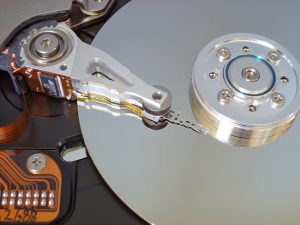
How Does A Hard Drive Work?
 Computers have become an integral part of our daily lives. With everything from leisure activities like social networking and browsing the web, to more serious tasks like drafting papers and getting work done, so many things are going digital these days. As a result, we spend a lot of time on our computers. Many people, however, rarely stop and take a moment to learn about how these incredible data storage machines work.
Computers have become an integral part of our daily lives. With everything from leisure activities like social networking and browsing the web, to more serious tasks like drafting papers and getting work done, so many things are going digital these days. As a result, we spend a lot of time on our computers. Many people, however, rarely stop and take a moment to learn about how these incredible data storage machines work.
One of the most important components of any computer is its hard drive. Hard drives are one of the most important aspects of your computer, as it cannot function without one. Your hard drive is the part of your computer that permanently stores information and handles data retrieval.
Hard drives are an advanced technology that is essential to the proper functioning of a computer. However, to properly understand how hard drives are able to operate so you can enjoy browsing the web, it is first necessary to understand precisely what function they serve in your computer.
What is a Hard Drive?
A hard drive is a memory hardware device stored inside a computer that serves the primary function of being able to store and retrieve data. The hard drive is made up of one or several platters, to which data is stored with the use of a magnetic head. These platters are stored inside of an air-sealed or filtered casing.
In simple terms, a hard drive is a magnetized storage space that is essential to your computer operating properly. Internal hard disks can be found in the drive bay, connected to the motherboard using a SATA cable, and are powered using a connection to the power supply unit.
Hard drives are incredible pieces of technology because they pose so much potential for storage in such a small physical space. For example, most people are absolutely astounded to learn that they are capable of storing thousands of songs on an iPod or another type of digital music player that is small enough to fit in the palm of their hand. When the iPod first came out, in particular, this technology was unimaginable to many people—but all those older iPods were, in essence, was a simple hard drive. They were computer memory devices with an incredible efficiency that used the simple technology of magnetism to store huge amounts of data—just like hard drives.
Hard drives have been around for over 50 years, and they’ve been commonly used in personal computers since the middle of the 1980s. While your computer also has a microprocessor that takes care of all the calculating parts of functioning properly, the hard drive is what allows your computer to access its excellent memory capabilities so you can store music, photos, text files, and so much more.
Now you understand what hard drives do and why they’re important. But how is it that they are able to store so much data in such a compact form?
Information Storage Using Magnetism

Image courtesy of explainthatstuff.com
Magnetism is a complex science, but even household items as simple as some nails and a magnet can reveal to you how simple the concept is in action. Iron nails, to begin with, are not magnetized; however, by rubbing over them with a magnet back and forth, they can become magnetic and stick to one another. This concept has practical uses as well, such as how junkyards use electromagnets, which are magnets that can be turned off and on through the use of electricity) in order to move around piles of metal scrap into a more useful position.
However, magnets serve another very important function; they can be used to store information. If there are only two possible types of data to store, then whether or not something is magnetized could be used to represent each message; this is where binary code comes in.
If you’ve heard before that all of the information stored on your computer can be boiled down to 1’s and 0’s, then that is completely correct—and this is why. With magnetized and unmagnetized bits of your hard drive representing those 1s and 0s, a vast amount of data is able to be stored. Your hard drive is composed of microscopically small iron nails called bits, each of which can store one tiny piece of information—essentially that 1 or 0 that makes up the language our computers speak.
Your computer’s hard drive is made of a large, shiny plate in the shape of a circle. It’s made out of magnetic material and is referred to as a platter. The platter is divided into billions of these tiny areas, each of which can independently be either magnetized or demagnetized. The magnetized bits store a 1, while the demagnetized bits store a 0. More information on hard drive magenetism here.
In computer storage, magnetism is used to store information because it can function and continue storing your information even during the hours that the power is switched off. When a nail is magnetized, it remains magnetized until someone demagnetizes it. In a very similar fashion, the data stored on your computer’s hard drive is able to stay there even without a power source fueling it at all times.
Accessing Data
Being able to store memory is very useful, but it means nothing at all if you are not able to access it at a later time. After all, all of those 1s and 0s are all but useless to humans until they are translated by a computer. With millions of magnetized and demagnetized bits, it’s necessary for your computer to have an extremely well-thought-out method of accessing information if it’s going to be able to present you with anything useful at all.
When data is stored on your computer’s hard drive, this is not simply done by throwing these magnetized bits together in a jumbled mess. Rather, the data is stored in an extremely orderly manner so the bits of data are able to be arranged in a way that makes sense. The information is placed in tracks, which are concentric, circular paths. These tracks are split up into smaller divisions referred to as sectors.
The hard drive also stores a map of the sectors that are already being used and those that are ready to store information. When there is new data to be stored on the hard drive, it utilizes this map to access a free sector. At this point, the read-write magnetized head moves across the platter to the precise location and stores the data appropriately. When it’s time to read the information, the same process is run in a reverse fashion.
The Possibilities of Hard Drives & Data Recovery
 As you can see, this technology is incredibly simple but presents vast opportunities for data storage. That is why hard drives have become such an integral part of technology today, so much so that many pieces of modern technology would not be able to function without them.
As you can see, this technology is incredibly simple but presents vast opportunities for data storage. That is why hard drives have become such an integral part of technology today, so much so that many pieces of modern technology would not be able to function without them.
With so much data capable of being stored in such a small area, hard drives do remarkable things and offer us a lot of potential to the world of technology. The benefits can scarcely be overstated, as it was once unimaginable to be able to store the information of 500 CDs on just on mp3 player or iPod, but hard drives do not come without their drawbacks. One such drawback is the fact that things can go wrong quite unexpectedly if anything goes wrong—such as them getting dust or dirt inside of them.
Even something as tiny and seemingly harmless as a tiny piece of dust can wreak havoc on your hard drive by making the read-write head bounce and crash into the platter. This will result in damaging the magnetic material, and the tragedy that follows is called a disk crash—something that you will remember the frustration of all too well if it has ever happened to you in the past. This can be the cause of the loss of all of the hard drive’s information in some cases.
Such disk crashes typically occur with no warning, which is why it is essential to keep information backed up as much as possible to minimize the damage to your information if it does happen unexpectedly. If you are the victim of a disk crash, data recovery is often possible in some cases if you take the proper steps quickly enough. By taking the right steps in advance, you can avoid costly data recovery.
Your hard drive does great things for the capabilities of your computer, but in the event that things go wrong, the situation can quickly become frustrating. This is especially true if you did not prepare for the event of your hard drive failing and did not regularly back up any important information you may have had stored on your computer. Common types of hard drive failure typically take two different forms, logical & physical. Fortunately, with data recovery engineers like Computer Fixperts, hard drive recovery is possible, allowing you to avoid the anguish of losing any important data you may be in danger of losing after a disk crash. If you have lost important data, it is recommended you seek professional data recovery services to give you the best shot at recovering your data. If you’re feeling brave and want to risk various methods of recovering data yourself, why not check out the best data recovery software available on the market. For the best chance at hard drive data recovery, get in touch with us today, we have experienced data recovery technicians that can assist you.
